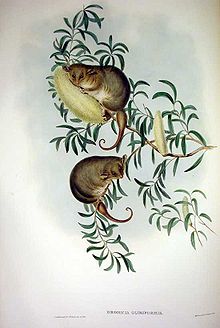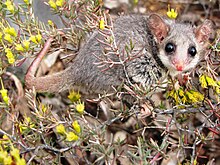| Eastern pygmy possum[1] Temporal range: Late Pleistocene - Recent
| |
|---|---|

| |
| Scientific classification | |
| Kingdom: | Animalia |
| Phylum: | Chordata |
| Class: | Mammalia |
| Infraclass: | Marsupialia |
| Order: | Diprotodontia |
| Family: | Burramyidae |
| Genus: | Cercartetus |
| Species: | C. nanus
|
| Binomial name | |
| Cercartetus nanus (Desmarest, 1818) | |
Description
Eastern pygmy possums are very small, weighing from 15 to 43 grams (0.53 to 1.52 oz) and having a body length of between 7 and 9 centimetres (2.8 and 3.5 in) with a 8 to 11 centimetres (3.1 to 4.3 in) tail. They are dull grey above and white below, with big, forward pointing, almost hairless, ears and a long prehensile tail, with thick fur at the base that becomes sparser towards the tip. They have long whiskers, and a narrow ring of dark fur around each eye.[5]
The eastern pygmy possum is an active climber. It uses its brush tipped tongue to feed on nectar and pollen, especially from Banksia, Eucalyptus and Callistemon species.[6] It also feeds on insects, and will eat soft fruits when flowers are not available. It is a largely solitary animal, sheltering in tree hollows and stumps, abandoned bird nests, and thickets. During winter it spends time in torpor.[6]
They are nocturnal, and, although generally thought to be solitary, have been reported to share communal nests, and to be seen in groups of two or more adult individuals. Males occupy home ranges of 0.24 to 1.7 hectares (0.59 to 4.20 acres), which overlap with each other and with the smaller, 0.18 to 0.61 hectares (0.44 to 1.51 acres) ranges of females.[5]
Distribution and habitat
Eastern pygmy possums are found along the southeastern Australian coast, from eastern South Australia to southern Queensland, and on Tasmania. They inhabit shrubby vegetation in a wide variety of habitats, from open heathland or shrubland to sclerophyll or rain forest, at elevations from sea level to 1,800 metres (5,900 ft). Despite this apparent diversity of habitats, their distribution is patchy, and they are usually low in number where they are found.[5]
https://en.wikipedia.org/wiki/Eastern_pygmy_possum


No comments:
Post a Comment